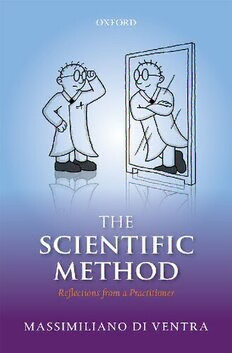Table Of ContentTHE SCIENTIFIC METHOD
THE SCIENTIFIC
METHOD
Reflections from a Practitioner
Massimiliano Di Ventra
UniversityofCalifornia
SanDiego,USA
1
3
GreatClarendonStreet,Oxford,OX26DP,
UnitedKingdom
OxfordUniversityPressisadepartmentoftheUniversityofOxford.
ItfurtherstheUniversity’sobjectiveofexcellenceinresearch,scholarship,
andeducationbypublishingworldwide.Oxfordisaregisteredtrademarkof
OxfordUniversityPressintheUKandincertainothercountries
©MassimilianoDiVentra2018
Themoralrightsoftheauthorhavebeenasserted
FirstEditionpublishedin2018
Impression:1
Allrightsreserved.Nopartofthispublicationmaybereproduced,storedin
aretrievalsystem,ortransmitted,inanyformorbyanymeans,withoutthe
priorpermissioninwritingofOxfordUniversityPress,orasexpresslypermitted
bylaw,bylicenceorundertermsagreedwiththeappropriatereprographics
rightsorganization.Enquiriesconcerningreproductionoutsidethescopeofthe
aboveshouldbesenttotheRightsDepartment,OxfordUniversityPress,atthe
addressabove
Youmustnotcirculatethisworkinanyotherform
andyoumustimposethissameconditiononanyacquirer
PublishedintheUnitedStatesofAmericabyOxfordUniversitypress
198MadisonAvenue,NewYork,NY10016,UnitedStatesofAmerica
BritishLibraryCataloguinginPublicationData
Dataavailable
LibraryofCongressControlNumber:2018931028
ISBN978-0-19-882562-3
DOI10.1093/oso/9780198825623.001.0001
Printedandboundby
CPIGroup(UK)Ltd,Croydon,CR04YY
To
Elena,Matteo,andFrancesca
ingratitudefortheircentralanduniqueroleinmylife
Preface
I am a theoretical physicist who has been working for
over twenty years in academia, publishing regularly in
refereed journals, teaching graduate and undergraduate
classes, training several graduate students and post-
graduateresearchers,travelingtheworldtoexchangeideas
at conferences, and enjoying the creative aspect of my
profession.
Overtheyears,however,whilediscussingwitheducated
laypeople interested in Science, students, and even some
researchers, I have come to realize that they attribute to
Science the ability to answer questions that have always
beenaddressedbyothersourcesofknowledge,inparticu-
lar,PhilosophyorReligion.
Withthisinmind,Ifelttheneedtodiscusstheseissues
with my own students. In particular, I wanted to better
viii Preface
conveytothemboththereachand,mostimportantly,the
limitsofScienceandtheknowledgewecanacquirefromthis
humanenterprise.
Encouragedbytheirfeedback,Iofferedtoteachaclasson
the scientific method in the Department of Physics of the
UniversityofCalifornia,SanDiego,inthefallof2012and
springof2013.
While researching for my lectures, I realized that the
misjudgedroleofScienceisoftenamplifiedbythefrequent
mis-representationofscientificdiscoveriesortheoriesbythe
media,withusscientistssometimescomplicitinthisact.
The unfortunate result is that oftentimes—pressed by
the obvious desire to increase readership—a scientific
hypothesis is elevated to a fact. These “news” spark the
imagination of laypeople, sedimenting into our collective
consciousness“truths”thathavemuchmoreincommon
withsciencefictionthanreality.
Navigatingscientifictopicsmaythenseemdaunting.Not
allofusaregroundedinadvancedMathematicsorPhysics
orotherdisciplinesnecessarytojudgethevalueofascien-
tificstatement.
Even the practitioners of a particular discipline cannot
claim expertise in all the other subjects of scientific
endeavor,andhencecannotdiscusswithfamiliarityallthe
bodyofscientificknowledgethatiscontinuallygenerated,
seeminglyatanever-increasingrate.
Whilethisworkingknowledgemaynotbeavailabletoall
ofus,itismyconvictionthatitisunnecessarytoevaluate
a scientific claim. In fact, Science rests on a well-defined
methodology thatprovidesaguidingsetofrulesforlearning
Preface ix
aboutNature,and,atthesametime,definestheboundaries
ofscientificinquiry.
WhetherwediscussBiologyorChemistryorPhysics,the
scientificmethodiscommontoallNaturalSciencesandisthe
fabricandthebackboneofscientificknowledge.Familiarity
with the scientific method is not only a necessary tool in
moderntimes,butitisalsowellwithinreachofeveryone,
whetherapractitionerlikeme,oraninterestedlayman.
Thisshortbookatalevelaccessibletofirst-yearunder-
graduate students of all Natural Sciences—and quite pos-
siblytohighschoolstudents—attemptstoprovidesucha
tooltoawideaudience.ItoriginatesfromthenotesIhave
writtenformyclassonthesamesubject.
By Natural Sciences I mean all those disciplines that
describephenomenaoccurringinNature,suchasPhysics,
Chemistry, and Biology. (Some of the points discussed in
thisbookmayalsoberelevanttotheSocialSciences,suchas
EconomicsorPsychology,whenempiricalapproachesare
employed.)
Although Mathematics is the language in which we
express many of these phenomena, its method and goals
are substantially different and will not be treated in this
book.
The book addresses the following concepts: objective
realityandapproximatedescriptionofnaturalphenomena;
the role of the observer; the difference among objective
facts, hypotheses, and theory; the meaning of “falsifi-
ability”; the “absence of democracy” in the pursuit of
scientific truths; and the fundamental and inalienable role
ofexperimentalevidenceinscientificknowledge.

